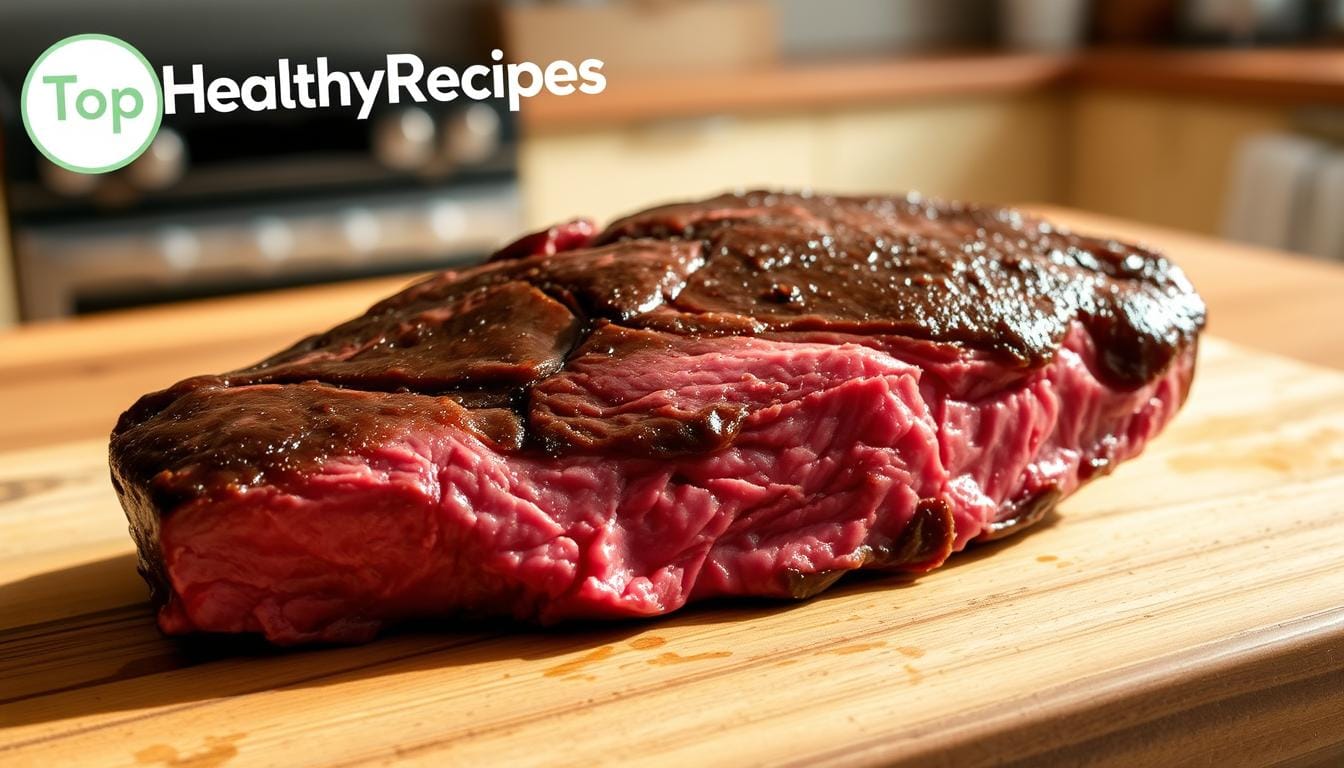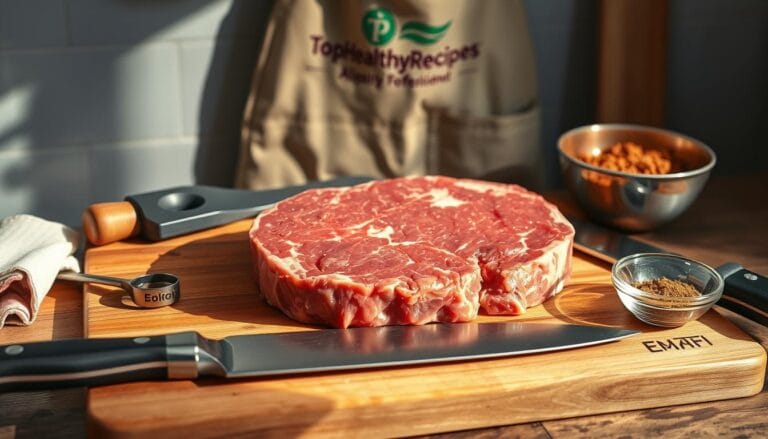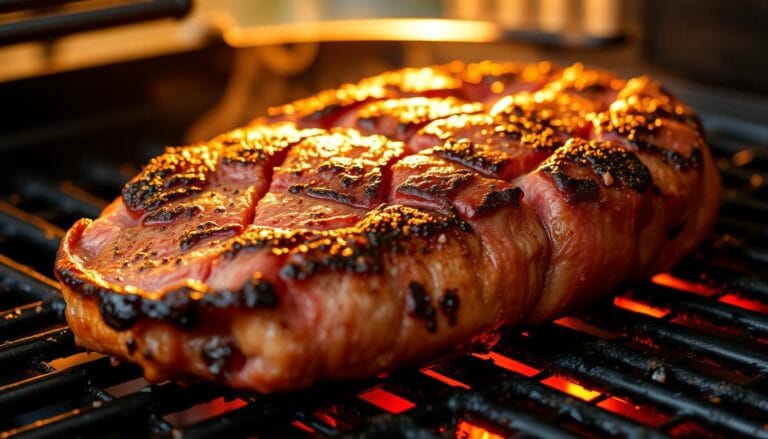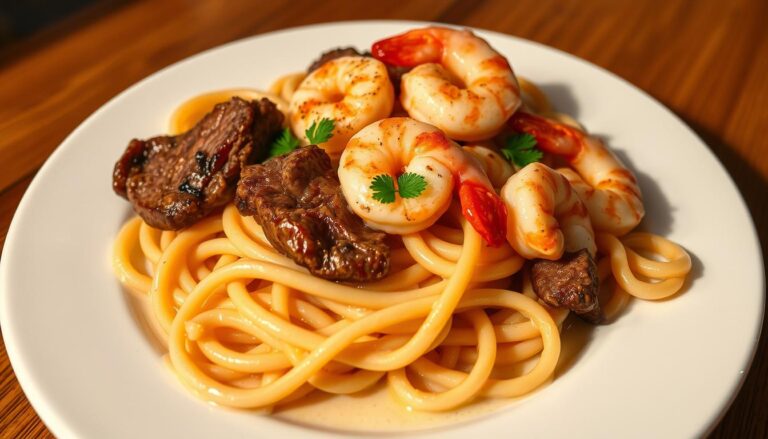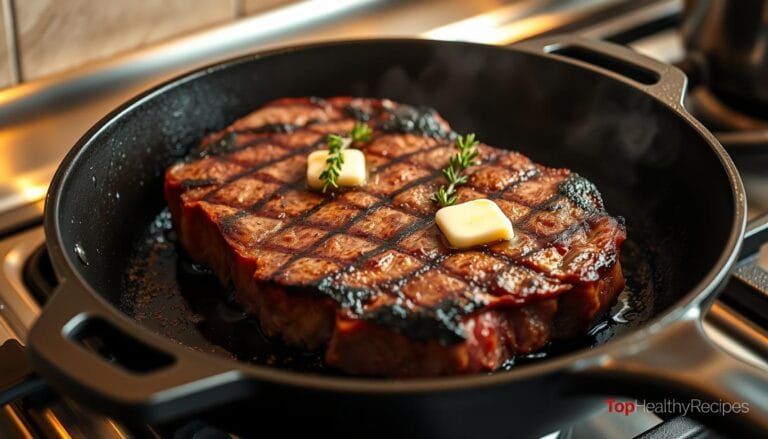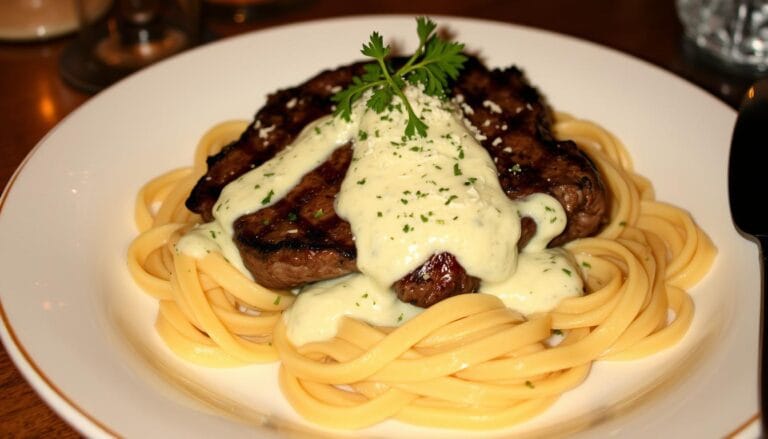Beef Coulotte: Juicy, Flavor-Packed Cut to Try
Table of Contents
Beef Coulotte: Juicy, Flavor-Packed Cut to Try
Looking to improve your cooking skills? Want a meat that’s both tasty and easy to use? The culotte steak is your answer. It’s a hidden treasure in the beef world, perfect for making delicious dishes.
This cut is great for many cooking ways, like grilling or pan-searing. Its tenderness and rich taste make it loved by both home cooks and chefs.
Key Takeaways
- Discover the versatility of beef coulotte in various recipes.
- Learn about the unique characteristics that make it a great choice.
- Explore different cooking methods to bring out its best flavor.
- Understand why it’s a favorite among chefs and home cooks.
- Get tips on how to prepare and cook this flavorful cut.
What is Beef Coulotte?
Beef coulotte, also known as top sirloin cap, is a prized cut. It’s known for its rich marbling and robust flavor. This cut comes from the top sirloin section, from the cap muscle. It’s tender and has a rich flavor profile.
Understanding the Cut
The beef coulotte has a triangular shape and is covered in fat. This fat enhances its flavor and tenderness when cooked. Its fine-grained texture makes it great for grilling or roasting.
Key characteristics of beef coulotte include:
- Rich marbling, which contributes to its flavor and tenderness
- Fine-grained texture, suitable for various cooking techniques
- A layer of fat, enriching the taste and texture
Origin and History
Beef coulotte comes from South American cuisine, mainly from Brazil. It’s known as “picanha” there. It’s a favorite for grilling and is popular in steakhouses and barbecue restaurants.
The history of beef coulotte is tied to traditional barbecue and grilling. In many cultures, the top sirloin cap is a delicacy. Its preparation methods have been perfected over generations.
Nutritional Benefits
Beef coulotte is not just tasty but also nutritious. It’s packed with protein, vitamins, and minerals. A 3-ounce serving has about 22 grams of protein.
| Nutritional Component | Amount per 3 oz serving |
|---|---|
| Protein | 22 grams |
| Fat | 15 grams |
| Iron | 3 mg |
| Zinc | 4 mg |
Beef coulotte is also rich in essential vitamins and minerals like vitamin B12, selenium, and zinc. It can be part of a balanced diet when eaten in moderation.
How to Select the Perfect Beef Coulotte
To get the best beef coulotte, knowing what to look for is key. Choosing a high-quality cut means understanding several important factors. These factors affect the taste, tenderness, and overall dining experience.
Factors to Consider
When picking a beef coulotte steak, several factors are important. First, think about the size and thickness of the cut. A thicker cut cooks more evenly, while a thinner cut cooks faster. Also, the fat cap is vital. A good fat cap makes the coulotte taste better and feel softer.
- Size: Pick a cut that fits your needs, whether for one or many.
- Thickness: A thicker cut (around 1.5 to 2 inches) is more forgiving when cooking.
- Fat Cap: Look for a cut with a decent fat cap for better flavor and tenderness.
Quality Indicators
Checking the quality of beef coulotte involves looking at several signs. Freshness is essential; the meat should smell fresh and pleasant. The color of the meat is also key; it should be a deep red, showing it’s fresh and of good quality. Marbling, or the fat flecks in the meat, adds to tenderness and flavor. Lastly, the texture should be firm.
- Freshness: Look for any off smells or slimy texture.
- Color: A deep red color means it’s fresh.
- Marbling: Enough marbling makes the meat tender and flavorful.
- Texture: The meat should feel firm to the touch.
Choosing the Right Grade
Understanding the USDA grading system is important for picking the right beef coulotte. The grades—Prime, Choice, and Select—show the meat’s quality and characteristics. Prime grade is the highest quality, with lots of marbling for tenderness and flavor. Choice grade is also high quality but has less marbling than Prime. Select grade is leaner and might be less tender.
- Prime: Highest quality with lots of marbling.
- Choice: High quality with less marbling than Prime.
- Select: Leaner and potentially less tender.
Talking to your butcher can also help you get the best cut. Don’t be shy to ask for their advice or help in picking the perfect beef coulotte for your needs.
Preparing Beef Coulotte for Cooking
To get the most out of your beef coulotte, proper preparation is key. This involves several steps that ensure your dish turns out flavorful and tender.
Thawing and Seasoning
If your beef coulotte is frozen, you’ll need to thaw it first. The safest method is to thaw it in the refrigerator, allowing 24 hours of thawing time for every 4-5 pounds of meat. Or, you can thaw it in cold water, changing the water every 30 minutes. Once thawed, pat the meat dry with paper towels to remove excess moisture.
Seasoning is a key step that enhances the natural flavors of the beef coulotte. Start with salt and pepper. You can also add garlic powder, paprika, or herbs like thyme or rosemary. Rub the spices into the meat to ensure they stick.
Ideal Marinades
A marinade can add extra flavor to your beef coulotte. For an acidic marinade, mix olive oil with lemon juice or vinegar, and add minced garlic and herbs. An oil-based marinade can include olive oil with soy sauce, Worcestershire sauce, and herbs. Let the beef coulotte marinate for at least 2 hours or overnight for more intense flavor.
- Acidic Marinade: olive oil, lemon juice, garlic, thyme
- Oil-Based Marinade: olive oil, soy sauce, Worcestershire sauce, rosemary
- Herb-Infused Marinade: olive oil, chopped fresh herbs, garlic
Trimming Techniques
Trimming your beef coulotte can affect the final dish’s flavor and texture. If your coulotte has a thick fat cap, trim it down to about 1/4 inch to prevent it from being too greasy. Use a sharp knife to remove any silverskin, as this can make the meat tough.
To trim the fat cap: Hold the knife at a 45-degree angle and carefully slice off the excess fat. Be cautious not to cut too much meat.
To remove silverskin: Slide the knife under the silverskin and gently pry it off. This will help the meat cook more evenly.
Cooking Methods for Beef Coulotte
Beef coulotte steak is versatile and can be cooked in many ways. Each method brings out a unique flavor. Whether you want a tender inside or a charred outside, the right method is key.
Grilling: Achieving the Perfect Char
Grilling is a favorite for beef coulotte, adding smoky flavor and a nice char. Start by heating your grill to high. Season the steak, then sear for 3-4 minutes on each side. Move it to a cooler part to finish cooking.
Tips for Grilling:
- Use a meat thermometer to ensure the steak reaches your desired internal temperature.
- Keep the grill lid closed as much as possible to maintain a consistent temperature.
- Let the steak rest for a few minutes before slicing to allow the juices to redistribute.
Roasting: Preparing for the Oven
Roasting is great for those who like a more evenly cooked steak. Preheat your oven to 400°F (200°C). Season the steak, then place it on a roasting rack. Roast until it reaches your desired doneness, using a meat thermometer.
Roasting Times:
| Doneness Level | Internal Temperature | Roasting Time (approx.) |
|---|---|---|
| Rare | 130°F – 135°F | 8-12 minutes |
| Medium Rare | 135°F – 140°F | 12-15 minutes |
| Medium | 140°F – 145°F | 15-18 minutes |
Sous Vide: For Precise Temperature Control
Sous vide cooking gives you exact temperature control. Season the steak, then seal it in a bag. Cook in a water bath at your desired temperature. Then, quickly sear it in a hot pan for a crust.
Benefits of Sous Vide: This method ensures even cooking, reducing overcooking risk.
Suggested Doneness Levels
To enjoy your beef coulotte at its best, understanding different doneness levels is key. Whether you prefer your steak rare, medium, or well-done, achieving the right level of doneness can make all the difference in its tenderness and flavor.
Rare to Well-Done: Your Guide
Beef coulotte can be cooked to various doneness levels, each with its unique characteristics. Here’s a breakdown:
- Rare: Internal temperature of 120°F – 130°F. The steak will be red and juicy on the inside.
- Medium Rare: Internal temperature of 130°F – 135°F. The steak will be slightly firmer than rare but will stay juicy.
- Medium: Internal temperature of 140°F – 145°F. The steak will have a hint of pink in the center.
- Medium Well: Internal temperature of 150°F – 155°F. The steak will be slightly firmer and have just a hint of pink.
- Well-Done: Internal temperature of 160°F and above. The steak will be fully cooked with no pink color remaining.
Using a Meat Thermometer
A meat thermometer is a key tool for achieving your desired level of doneness. It ensures accuracy and takes the guesswork out of cooking. There are different types of thermometers available, including instant-read, leave-in, and wireless models. For the most accurate reading, insert the thermometer into the thickest part of the steak, avoiding any fat or bone.
Benefits of Each Doneness Level
Each doneness level offers a unique dining experience. For instance, cooking your beef coulotte to rare or medium rare preserves its tenderness and juiciness, making it ideal for those who enjoy a softer texture. On the other hand, well-done steak is better for those who prefer their meat fully cooked, though it may be less juicy.
As noted by culinary experts, “The key to a great steak is not just in the cut, but in how it’s cooked.” The doneness level can significantly affect the overall flavor and texture, so it’s worth experimenting to find your perfect match.
Delicious Beef Coulotte Recipes
Explore the rich flavors and textures of beef coulotte through these tasty recipes. They show how versatile it is in different dishes.
Classic Coulotte Steak Recipe
This classic recipe brings out the natural taste of beef coulotte. You’ll need:
- 1 beef coulotte steak (about 1.5 pounds)
- 2 tablespoons olive oil
- 1 tablespoon garlic powder
- 1 tablespoon paprika
- Salt and pepper to taste
First, heat your grill to medium-high. Season the steak with garlic powder, paprika, salt, and pepper. Grill for 5-7 minutes on each side, until it’s cooked to your liking. Let it rest for 10 minutes before slicing thinly against the grain.
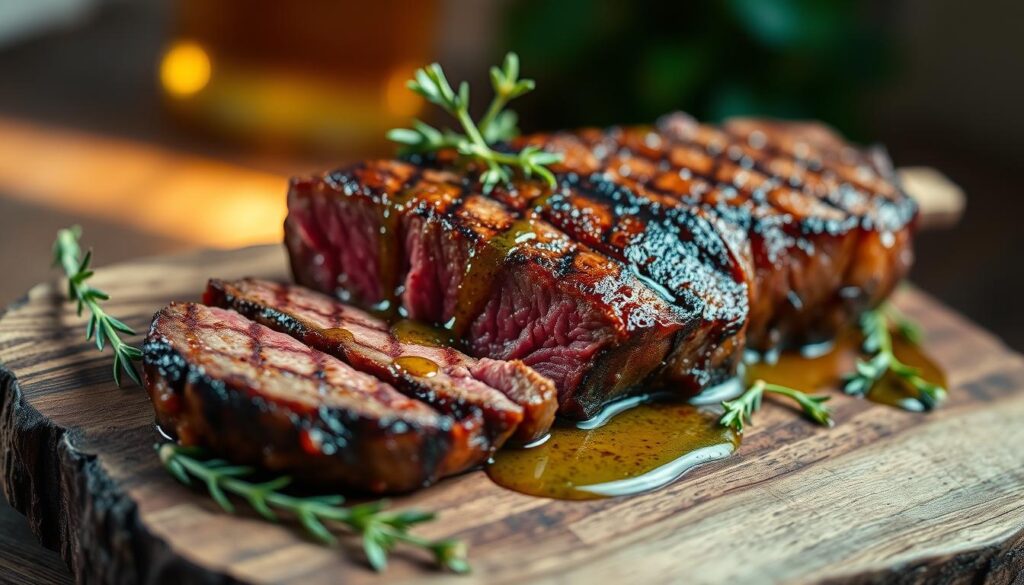
Beef Coulotte Tacos: A Flavorful Twist
Turn your beef coulotte into a tasty taco filling. Start by marinating the steak in:
- 1/4 cup lime juice
- 2 cloves minced garlic
- 1 teaspoon dried oregano
- 1/4 cup chopped cilantro
Grill the marinated steak until it’s cooked to your liking. Slice it thinly. Serve in tacos with your favorite toppings, like diced onions, salsa, avocado, and sour cream.
Stir-Fried Coulotte with Vegetables
For a quick meal, slice the beef coulotte thinly and stir-fry it with your favorite veggies. You’ll need:
- 1 cup sliced beef coulotte
- 2 cups mixed vegetables (bell peppers, broccoli, carrots)
- 2 tablespoons soy sauce
- 1 tablespoon olive oil
Heat olive oil in a wok or large skillet over high heat. Add the sliced beef coulotte and cook until browned. Then, add the mixed vegetables and soy sauce. Stir-fry until the veggies are tender. Serve over rice or noodles.
These recipes show how versatile beef coulotte is. It can be a classic steak or a creative dish like tacos or stir-fries. Try different seasonings and cooking methods to find your favorite way to enjoy it.
Pairing Sides with Beef Coulotte
To make a great meal, pair your beef coulotte with sides that match its flavor. The right sides can make a simple dish unforgettable.
Suggested Vegetables
Vegetables are key to a balanced meal. For beef coulotte, roasted and fresh veggies are great. Roasting veggies like Brussels sprouts and carrots brings out their sweetness, matching the meat’s savory taste. Just toss them with olive oil, salt, and herbs, then roast until tender.
Fresh veggies offer a cool contrast to the coulotte’s richness. A simple salad with mixed greens and a light vinaigrette can refresh your palate between meat bites.
Complementary Starches
Starches are vital for a filling meal with beef coulotte. Potatoes are a top pick, and can be mashed, roasted, or twice-baked for extra flavor.
Grains like rice pilaf, quinoa, and farro are nutritious and tasty alternatives to potatoes. Season them with herbs and spices to match the coulotte’s flavors.
| Starch | Preparation Method | Flavor Profile |
|---|---|---|
| Potatoes | Mashed, Roasted, Twice-Baked | Comforting, Rich, Earthy |
| Rice Pilaf | Sautéed with Aromatics | Light, Flavorful, Slightly Nutty |
| Quinoa | Cooked with Broth | Nutritious, Slightly Bitter, Earthy |
Perfect Sauces and Condiments
The right sauce or condiment can boost your beef coulotte’s flavor. Try chimichurri, a tangy Argentinean sauce, béarnaise, a creamy French sauce, or red wine reduction for a fruity taste.
For something new, try flavored butters, aiolis, or salsas. They add a unique touch without hiding the beef’s natural taste.
Storing and Reheating Leftover Coulotte
Storing and reheating leftover beef coulotte right is key. It keeps the flavor and texture great. Whether you grilled, roasted, or cooked it sous vide, taking care of leftovers means you can enjoy it again safely and well.
Proper Storage Techniques
To keep your leftover beef coulotte fresh, follow these tips:
- Refrigeration: Put the coulotte in a sealed container in the fridge at below 40°F (4°C). Use it in 3 to 4 days.
- Freezing: Wrap it tightly in plastic wrap or foil, or use a vacuum sealer to avoid freezer burn. Label and date it, and freeze at 0°F (-18°C) or below. Frozen coulotte stays good for up to 3 months.
- Signs of Spoilage: Look for bad smells, a slimy feel, or mold. If you see these, throw it away.
Best Reheating Methods
Reheating your leftover beef coulotte right is as important as storing it. Here are some ways to do it:
- Low-Temperature Oven: Heat your oven to 200°F (90°C). Put the coulotte on a baking sheet and cover with foil. Heat until it’s 120°F (49°C) to 130°F (54°C) for medium-rare.
- Sous Vide Reheating: Seal the coulotte in a sous vide bag and heat at 130°F (54°C) to 135°F (57°C). This keeps the temperature just right.
- Steam Reheating: Use a steamer basket to gently reheat the coulotte. This keeps it moist.
- Stovetop Reheating: Slice the coulotte thinly and reheat in a skillet over low heat. Add oil or broth to keep it moist.
You can also get creative with your leftovers. Try making beef coulotte sandwiches, salads, or hash with veggies. It’s a great way to reduce waste and enjoy a new meal.
Health Benefits of Red Meat
Beef coulotte steak is not just tasty but also packed with nutrients. It’s a great choice for anyone looking to eat well.
Protein and Iron Content
Beef coulotte is full of high-quality protein, which is key for muscles. A 3-ounce serving has about 22 grams of protein. It also has a lot of iron, which is good for the body.
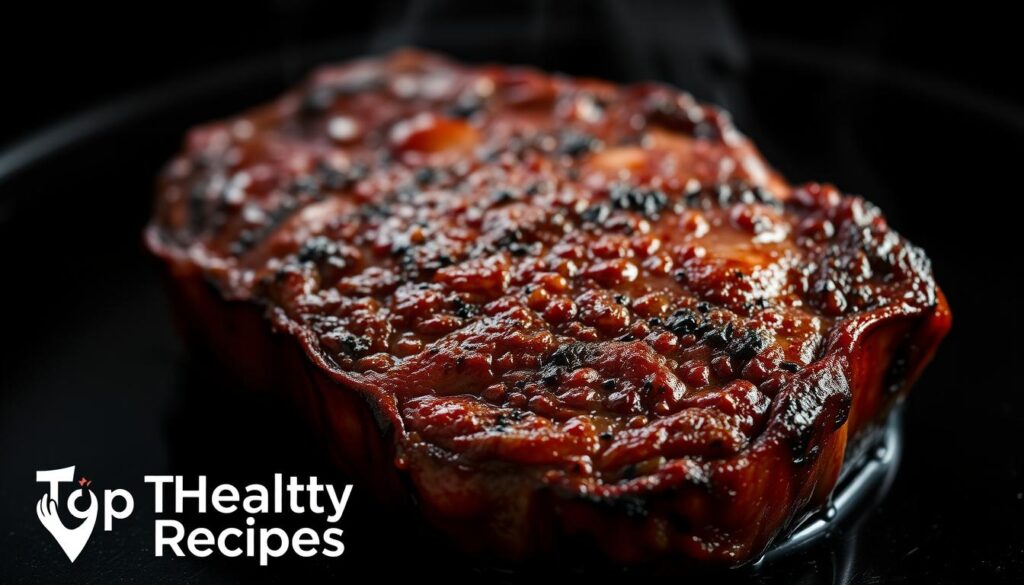
Role in Balanced Diets
Beef coulotte fits well into many diets. Health experts say to eat lean meats like it in moderation. It’s part of diets like the Mediterranean and DASH.
Pair beef coulotte with veggies and whole grains for a balanced meal. This boosts the meal’s nutrition and taste.
Choosing Lean Cuts
Choosing lean cuts of beef coulotte is important. It helps keep calories and fat down. Cooking it without extra fat, like grilling, makes it even healthier.
Trimming fat before cooking helps too. Grilling or roasting lets fat drip off, making beef coulotte steak a better choice.
Common Mistakes When Cooking Beef Coulotte
Cooking beef coulotte to perfection can be tricky. Knowing common mistakes helps improve your results. To enjoy the full flavor of beef coulotte, avoid mistakes that can ruin your meal.
Overcooking the Meat
Overcooking is a common mistake with coulotte steak. This cut becomes tough and dry if overcooked. To avoid this, watch the cooking time and temperature closely.
Using a meat thermometer helps get the right doneness. If your beef coulotte is a bit overcooked, slicing it thinly helps.
Skipping Resting Time
Resting your beef coulotte after cooking is key. When meat cooks, proteins contract and juices move to the surface. Resting allows proteins to relax and juices to spread, making the coulotte steak tender and flavorful.
The resting time depends on the cut’s thickness and cooking method. Usually, 5 to 10 minutes is best.
Not Using Enough Seasoning
Seasoning is essential for the best flavor in your beef coulotte. It’s not just salt and pepper; it’s about layering flavors. Season before, during, and sometimes after cooking.
For coulotte steak, try a marinade or rub that matches its rich taste. Adjust seasoning based on cooking method to balance and enhance flavors.
Serving Suggestions for Beef Coulotte
Serving beef coulotte with style can make any meal special. Whether it’s a dinner party or a quiet night in, the right presentation and pairing can elevate your dining experience.
Recommended Portion Sizes
Think about the occasion and other dishes when planning your meal. For a main course, 6-8 ounces per person is typical. For a larger spread, consider smaller portions, about 3-4 ounces per person.
- For appetizers, slice the beef coulotte thinly and serve 2-3 ounces per person.
- For lunch or dinner, aim for 6-8 ounces per person.
- At a buffet, serve 3-4 ounces per person.
Presentation Ideas
The presentation of your beef coulotte can enhance the meal’s ambiance. Here are some ideas:
- For family-style service, slice the beef against the grain and arrange it on a large platter with garnishes like fresh herbs or roasted vegetables.
- For individual plates, place a single slice of beef coulotte steak on each plate with sides like roasted vegetables or sautéed greens.
- For a buffet, slice the beef into thin strips and arrange them on a tiered serving dish.
Pairing with Wine or Beer
The right drink can enhance your beef coulotte’s flavors. For wine, choose a red with moderate tannins to match the meat’s rich flavor. For beer, a malty, caramel-flavored brew complements the charred, savory aspects of grilled beef coulotte.
- For wine, Cabernet Sauvignon, Syrah/Shiraz, or Malbec pair well with beef coulotte.
- For beer, Amber Ale, Brown Ale, or Stout are good choices.
Exploring Alternative Cuts
Beef coulotte, also known as culotte steak, is a versatile cut. It offers a great mix of flavor and tenderness. But, different cooking needs might call for other cuts.
Comparing Flavor and Texture
Beef coulotte differs from cuts like tri-tip or strip steak. Tri-tip is leaner and can dry out if overcooked. Strip steak is richer and more tender.
Choosing the Right Alternative
If coulotte is not available, look for substitutes. For grilling, try tri-tip or flank steak. Adjust cooking times based on the cut’s thickness and your desired doneness.
Adjusting for Different Cuts
Substituting coulotte with other cuts requires adjustments. Thicker cuts like strip steak need lower oven temperatures and longer cooking. Thinner cuts like flank steak cook quickly at high heat.
FAQ
What is beef coulotte?
How do I select the perfect beef coulotte?
What are the best cooking methods for beef coulotte?
How do I achieve the perfect doneness with beef coulotte?
Can I use beef coulotte in different recipes?
How should I store and reheat leftover beef coulotte?
What are some common mistakes when cooking beef coulotte?
How can I pair beef coulotte with sides and beverages?
What are the health benefits of consuming beef coulotte?
Can I substitute beef coulotte with other beef cuts?
What is the ideal marinade for beef coulotte?
How do I trim beef coulotte for cooking?
For more cooking tips, stay connected with us. We also recommend the cookbook Skinnytaste Simple: Easy, Healthy Recipes with 7 Ingredients or Fewer
For more Recipes about Steak ?
Did You try our recipe ?
There are no reviews yet. Be the first one to write one.
